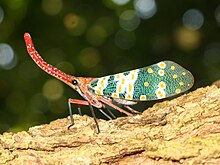| Fulgoridae | |
|---|---|

| |
| Pyrops candelaria | |
| Scientific classification | |
| Domain: | Eukaryota |
| Kingdom: | Animalia |
| Phylum: | Arthropoda |
| Class: | Insecta |
| Order: | Hemiptera |
| Suborder: | Auchenorrhyncha |
| Infraorder: | Fulgoromorpha |
| Superfamily: | Fulgoroidea |
| Family: | Fulgoridae Latreille, 1807 |
| Subfamilies | |
|
See text
| |
The family Fulgoridae is a large group of hemipteran insects, especially abundant and diverse in the tropics, containing over 125 genera worldwide. They are mostly of moderate to large size, many with a superficial resemblance to Lepidoptera due to their brilliant and varied coloration. Various genera and species (especially the genera Fulgora and Pyrops) are sometimes referred to as lanternflies or lanthorn flies, but neither do their heads emit light, nor are they even distantly related to flies.
The head of some species is produced into a hollow process, resembling a snout, which is sometimes inflated and nearly as large as the body of the insect, sometimes elongated, narrow and apically upturned. It was believed, mainly on the authority of Maria Sibylla Merian, that this process, the so-called lantern, was luminous at night in the living insect. Carl Linnaeus adopted the statement without question and coined a number of specific names, such as laternaria, phosphorea and candelaria to illustrate the supposed fact, and thus propagated the myth.